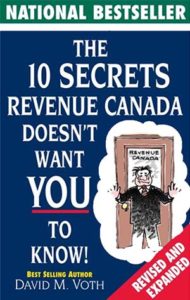BUY AN INSURANCE TAX SHELTER
 The life insurance industry is a tax haven, and will likely always enjoy that status, because of all the special laws created just for it. You can spend time wondering why, or you can use their heavily favoured status to your advantage!
The life insurance industry is a tax haven, and will likely always enjoy that status, because of all the special laws created just for it. You can spend time wondering why, or you can use their heavily favoured status to your advantage!
One popular strategy is the Life Insurance Tax Shelter. Over the last 15 years Canadians have stuffed millions and millions of dollars into these programs. The reason is that they allow either tax-deferred or TAX-FREE treatment of your investment dollars, with no risk. It’s the best onshore tax avoidance investment strategy available!
What Is An Insurance Tax Shelter?
An Insurance Tax Shelter is a plan issued by a life insurance company that allows you to deposit any amount of money and shelter all of the growth of the investment from income tax. Each insurance company gives their plan its own unique name.
How Does It Work?
Revenue Canada allows insurance companies to issue these plans and maintain their tax-sheltered status as long as they satisfy certain conditions. These plans are considered “exempt” by Revenue Canada under sections 12.2 and 148 of the Income Tax Act. The insurance company must maintain a minimum amount of life insurance on each plan to keep it tax exempt. This insurance however, can and should be low cost decreasing coverage, only enough to keep the plan tax exempt. The amount of life insurance necessary is based on a Revenue Canada formula and each plan must meet an annual test.
What Makes The Strategy Work?
Why do these plans outperform other non-sheltered investments?
First, Your earnings build-up TAX-FREE within the plan
Second, the annual expense charges of the plan cost less than the tax, which would have to be paid on the annual investment earnings of a similar non-sheltered investment.
EXAMPLE: Assuming a 10% annual rate of return. A couple, both age 45, in a 50% tax bracket would have to pay a total of $43,244 of income tax on the earnings of an investment of $10,000 per year over 10 years.
By contrast, if they invested $10,000 per year for 10 years into a tax-sheltered insurance account, earning the same rate of return; they would pay only $10,701 in total expense charges to the insurance company over the 10 years.
These plans are flexible, allowing you to vary the amount of your deposits and choose the type of investments, from GICs to investment fund indexes, with no restriction on foreign content.
HOW DO YOU GET YOUR MONEY OUT?
When it comes time to take income, you can generate income from your plan one of two ways:
- You can make direct withdrawals, TAX-FREE from the tax-sheltered account, up to the adjusted cost base (ACB) of the plan without incurring any tax. Simply stated, the ACB is equal to your deposits less the cost of insurance. Once you have withdrawn the TAX-FREE portion of the account, Revenue Canada will consider any further withdrawals to be taxable. Your insurance company can tell you what the ACB is for your account so that you don’t withdraw more than you want to.
- Under a special arrangement, you can leverage your account with a bank. This is the real benefit of an Insurance Tax Shelter! The leveraging of your account is what allows the plan to outperform other investment vehicles, because a loan is never taxable!
How Is It Structured? When it comes time to take income from your plan, the bank will accept your plan as security for a loan. You can then make a single loan or a series of annual loans that you will use as income. The bank will capitalize the loan payments, so that you never have to payments on the loan. Because the tax-sheltered growth within the plan continues to grow TAX-FREE the bank has an ever-increasing asset with which to secure each year’s loan. The loan is eventually repaid from the TAX-FREE insurance payout, when you die. And then, the insurance payout in excess of the bank loan balance is paid out TAX-FREE to your beneficiaries. Since a loan is not taxable, this plan allows you to EARN ALL OF YOUR INCOME TAX-FREE!
BONUS – If you die before you can spend or withdraw all of the money in your plan, the balance of the tax-sheltered account, plus the insurance amount, is paid TAX-FREE to your beneficiaries. And, insurance payouts avoid probate.
The following is an example illustration supplied to me by a certified financial planner who represents one of the 35 insurance companies that offer Insurance Tax Shelters. Don’t get hung up by the by the numbers, because every illustration is unique, relative to variables such as age, gender, smoking status, interest rates, etc. The purpose of this example is just to show the effect of the TAX-FREE income that can be generated from these plans. Your financial planner can generate a personalized illustration for you:
EXAMPLE: This illustration assumes you deposit $13,500 annually into the plan for 18 years and then start to take a TAX-FREE bank loan starting in the 24thyear. The lending institution would extend annual TAX-FREE loans to you of $78,905 adjusted annually for a 2% cost of living adjustment for the next 31 years.
By contrast, if you attempted the same thing with an RRSP depositing $13,500 for 18 years and then took the same level of after-tax income starting in the 24th year, you would exhaust your RRSP in as little as 9 years. That’s the impact of TAX-FREE income in retirement. Plus with the Insurance Tax Shelter, since you had no taxable income, you still qualify for the maximum Old Age Security payments.
Now if we examine what would happen if we used a non-tax-sheltered investment, the effect is even more staggering. Using the exact same assumptions of:
Deposits, rate of return and income at retirement, a fully taxed investment would be exhausted in slightly less than 5 years. That’s because it does not enjoy the tax-sheltered growth of either an Insurance Tax Shelter or an RRSP.
Another observation of the Insurance Tax Shelter reveals what happens if you don’t live until retirement. Suppose you died after 10 years of making deposits. The Insurance Tax Shelter reveals what happens if you don’t live until retirement. Suppose you died after 10 years of making deposits. The Insurance Tax Shelter would provide $1,000,000 TAX-FREE to your beneficiaries. While the RRSP would only be worth approximately $200,000; but Revenue Canada would grab half of it, leaving your family a TAX-FREE equivalent of only $100,000!
10 Times more For Your family!
Look at it this way- 20 years from now; you’re either dead or alive. If you’re alive, no other plan will pay you more after tax income. And if you’re dead, no other plan will pay more money to your family- and do it TAX-FREE!
Retirement Income Strategy – When you start to use your assets to fund your retirement income, use the funds from your least tax efficient investments first. As we saw from the example a non-registered investment can only provide income about half as long as an RRSP and an RRSP less than a third as long as an Insurance Tax Shelter. Therefore, it is prudent to use funds from your non-registered (non-sheltered) investments first, then your RRSP assets and finally tap your Insurance Tax Shelter. This strategy will give you the best bang-for-the-buck while you’re alive! And after you die, all the value left in your Insurance Tax Shelter will be paid out TAX-FREE directly to your named beneficiaries, avoiding your estate and probate tax.
Who Else Says So?
Besides the insurance industry and me writing this book telling you how great these plans are at exploiting the tax laws, it’s always good to know if there are other credible recommendations from other professionals. Accountants are recommending these plans to their clients. This is what they are saying:
“Tax-sheltered insurance accounts are an excellent way of building assets for retirement. At retirement, borrowing tax-free income is a strategy that will maximize spendable income while avoiding benefit clawbacks and reducing or eliminating tax payable.”
Terry Laughren, Chartered Accountant
“Individuals looking for tax shelters or deferral mechanisms may wish to explore the benefits that maybe derived from an “exempt’ life insurance policy. Such policies may be a powerful tool in the tax planning arsenal, particularly when many other tax shelters appear to have been curtailed.”
“The returns from virtually tax-free accumulation after the deduction of the insurance costs, compared to taxable accumulations, can, over a long period, be quite remarkable.”
Tax Planning Checklist
Price Waterhouse Coopers
“The life insurance industry has developed attractive and highly sophisticated products that can help you meet two planning objectives at once: having insurance coverage, and providing retirement income from tax-sheltered growth. These policies allow you to pay insurance premiums and make deposits to a tax-sheltered investment account at the same time. Professional advice is a must when assessing the merits of this type of investment.”
Tax Planning for You and Your Family
KPMG Accountants
“The past decade has seen tremendous change in the financial services sector- regulatory change has resulted in new competitors and a proliferation of unique and sophisticated products and services. The insurance industry, once considered a sleepy backwater in the financial community, has recognized the need to change in order to survive and is now on the forefront on many new developments in products and services.”
The Canadian Guide to Wealth Preservation and Accumulation
Canadian Institute of Chartered Accountants
I recommend these plans to wide age range of people. From young people in their early 20’s, starting their first investment plan; to seniors in their late 60’s, looking for ways to shelter money in retirement.
It’s hard to find situations where these tax-sheltered insurance accounts aren’t superior to other types of comparable investments. Not all products offered by insurance companies are the same, and you should make sure the financial planner who you’re dealing with works with sound institutions. However, assuming that is the case, you will be amazed at how much extra money you could end up with, down the road, and by not paying taxes as you go! Life insurance tax-sheltered investments have very unique positions in the tax laws, and should be investigated at every opportunity.
Let’s review the features and benefits of owning an Insurance Tax Shelter:
- Deposit flexibility-You can change both the frequency and amount of your deposits
- TAX-FREE build-up of earnings within the plan
- TAX-FREE income through an innovative loan program when required
- TAX-FREE money to heirs upon death
- Creditor proof-money in the plan can never be seized by creditors
- Complete choice of investments with no restriction on foreign content
- Assets in the plan can be used as collateral
- No mandatory or minimum income payments in retirement- If you don’t need the income you can continue sheltering the growth within the plan
- Since income from the plan is not included in taxable income, the plan could prevent clawbacks on Old Age Security payments or other benefits
An Insurance Tax Shelter is truly a Win-Win-Win plan. Your investment stays TAX-FREE while it is building up within the plan in retirement. And when you’re gone, the rest of the money goes to your heirs TAX-FREE! Revenue Canada never sees one red cent in this strategy. In my books that’s WINNING!

